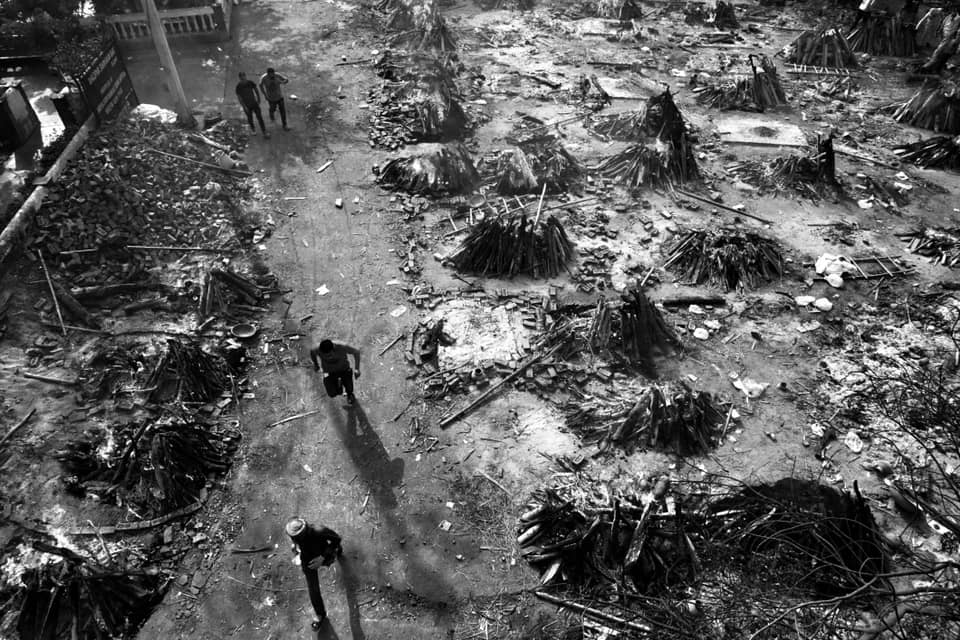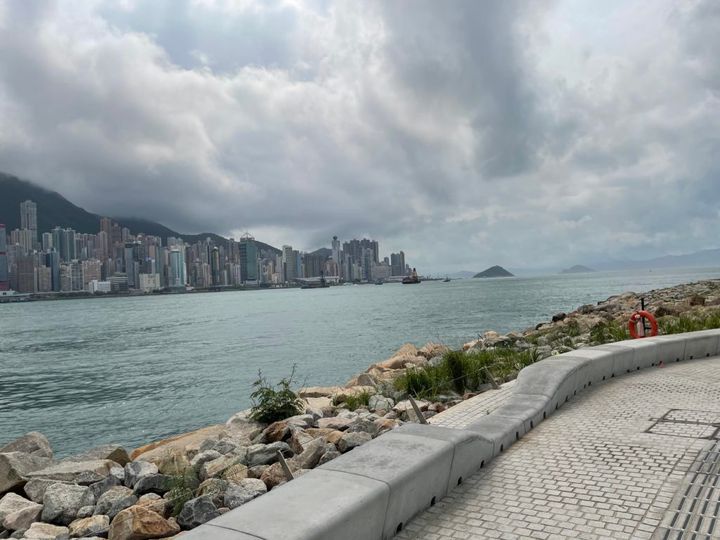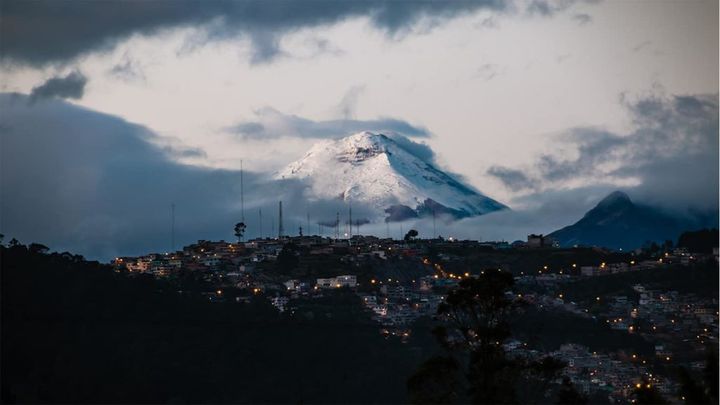Thousands dead and the rest pleading for oxygen and medical care, burning funeral pyres and bodies stacked up along public streets, cremation grounds meant for animals used for humans out of lack of space, hospitals running out of beds, families wailing as their relatives gasp for air, ambulances booked for whoever offers the highest price — these are not scenes from an imagined dystopian future, but India’s capital city New Delhi’s reality today. India, with a population of more than 1.38 billion, is currently one of the countries worst hit by the second wave of COVID-19. As of May 9th, the country has recorded 2,22,95,875 positive cases and more than 241,808 deaths. With around 400,000 cases per day, the country is also recording the highest daily count in the world. As a result, India accounts for nearly 20% of all active global cases and close to 7% deaths, translating as one of every five cases and one of every sixteen deaths. States like Maharashtra, Karnataka and Kerala have been reporting the greatest number of cases per day, close to 40,000, for weeks now. While Maharashtra continues to record the highest number of deaths (more than 75,000), New Delhi comes second (19,000), and Karnataka a close third, (18,000).
The unprecedented surge has critically affected the country’s ill-prepared health system, leading to its complete breakdown and a pulverising public health disaster. While the entire population seems to be at the receiving end of this mega catastrophe today, the marginalised remain the most affected and uncared for, just as from the beginning of the breakout in 2020. As established ample times by now, a vile blend of Hindutva, neoliberal economic planning and administrative blunders form the Indian government’s response to the virus outbreak. As a consequence, the onus and responsibility to fight it has shifted squarely to the common public and non-governmental entities, giving rise to thousands of volunteer groups, mass organisations consolidating relief efforts, and social media inundated with desperate calls for help on a daily basis. In a context where dissent is either suppressed or disallowed citing COVID-19 restrictions, these relentless calls and efforts for relief could also be seen as the common Indian’s marks of resistance against an unsympathetic state.
This article is being written in the background of the devastating news of the COVID-death of Mahavir Narwal, activist and father of Natasha Narwal. A student activist who was an active participant in the people’s movement that arose against the Citizenship Amendment Act, Natasha was imprisoned in 2020 on alleged “terror charges”, despite lack of evidence. Ignoring the demands for her release, she has continued to languish in prison without bail all throughout the pandemic. Natasha did not get to see her father when his state was critical, and his death today is a tragic reminder of the Indian state’s carelessness towards this health crisis, as well as of how the crisis is being used to push forward their agenda against dissent.
Govt Response: Hindutva, Neoliberalism, and Blunders
By becoming a global hotspot for COVID-19, India has gained large scale international attention by now, with some countries and organisations even offering support. At the same time, India’s own government, led by the far-right Bharatiya Janata Party (BJP) is yet to receive its wakeup call, with their response to the situation being marked by consistent incompetence. What Prime Minister Narendra Modi stressed in his last public address was the need to follow “COVID-appropriate behaviour” in people’s personal lives, rather than providing much information on what the government intends to offer as support in this scenario, while himself admitting that the “second wave has hit us like a storm”.
The BJP government’s strategy to fight the alarming situation today, among other things, is a triad of privatising healthcare, fund cutting public health, and making gross logistical mistakes as part of vaccine production. Overestimating its own capacity and in an effort to commercialise vaccine production, the Indian government gave near-exclusive rights to two private companies, the Serum Institute of India and Bharat Biotech, to produce ‘Covishield’ and ‘Covaxin’, the two shots approved for emergency use by India. No public sector player has so far been brought into the picture and all of this has led to some disastrous consequences for vaccine availability in India. While the government suggests that it would receive around 184 million doses by July, economists and scientists argue that this would fall extremely short as India is in need of at least 6.9 million doses per day to vaccinate its population above 18 years (adult) by January 2022. If tallied with this data, the amount promised would only cover around 2 million doses per day, a dangerously low count. It is further estimated that the states would receive even less, around 0.8-1 million doses, covering less than 30% of their adult populations.
That the second wave has crippled India’s health system is agreed upon, but what the situation has also exposed is that such a ‘system’ did not exist in the first place. Between September 2020 and January 2021, the country saw a drastic decline in the number of oxygen-supported beds, ICU beds and ventilators, right before the second wave hit. Data shows that while in September India had 2,47,972 oxygen-supported beds, by January 2021, the number fell to 1,57,344, a decrease of 36.54%. Experts attribute this to the government’s disinterest in continuing their medical infrastructural efforts once there was a drop in COVID-cases after the first wave. Most COVID-deaths that New Delhi and its neighbouring states have been reporting today are due to a critical lack of oxygen cylinders and beds. So grave is the situation that the Allahabad High Court has declared that such deaths must be considered as “genocides” carried out by those at the helm of affairs. As per the government’s own admission, India only has around 0.8 doctors and 1.7 nurses available for every 1000 Indians. It has also been reported that only 5.3 beds and 2.3 critical care beds are available for every 1000 Indians. Both the Economic Survey of 2020-21 as well as the report of the 15th Finance Commission have emphasised an urgent need to increase public investment in healthcare. However, in 2018, the government’s expenditure on health was a staggeringly low 3.5% of GDP, which has remained more or less consistent for decades now.
India has also experienced a sudden spike in unemployment in this period, with around 17 million losing their jobs following the complete shutdown of most enterprises and industries. Despite this, government expenditure for the revival of livelihoods and the rehabilitation of the unemployed in 2020-21 amounts only to about 1.5% of GDP. The labour laws recently passed by the government without due public consultation weaken job security, social security, and labour law enforcement, and also allow employers to increase work hours to 12 hours a day. The exodus of the migrant labourers from urban epicentres of the virus like New Delhi, with about 971 of them dying non-COVID deaths on the way, cannot be forgotten. The fear of dying of hunger is much greater than the fear of dying of the virus, say the workers who have begun to leave cities this year too, as a result of sudden lockdowns and lack of state support.
All this while, the government has involved itself in what is being criticised as a complete wastage of public funds on activities that have no relevance to the pandemic. The criticism is mainly directed at the government’s new project designed to re-establish the apparently lost glory of New Delhi, where the health crisis is at its peak. ‘The Central Vista Reconstruction Project’, as it is named, aims to rebuild the 3.2km stretch of land that lies at the heart of New Delhi’s Lutyens area, the political centre of the city built by the British. The project involves the razing down of older buildings and the construction of new ones, including a new Parliament, and amounts to $1.8 billion. Critics and experts, who have termed this an “exercise in vanity”, have stated how the amount spent for the project could be utilised to build around 40 new hospitals in Delhi alone. However, no criticism has affected the government, which has gone on to declare it an “essential service”. Hundreds of labourers continue to toil day in and night for the project, even through the city’s many COVID-19 lockdowns.
The political decisions that the Indian government made in this period, which may have no direct association with the virus, must come under scrutiny too. The slew of political incarcerations — students, activists, comedians, intellectuals, poets – when the pandemic was at its peak of intensity across the world in 2020, and the indifference expressed in the case of those arrested before, questions the state’s true priorities. Furthermore, last month, various states witnessed elections to their legislative assemblies. Elections to the state of West Bengal were drawn out into eight phases, by the end of which the country’s daily coronavirus count was well into 200,000 or more. The Madras High Court observed that the Election Commission of India had to be filed with “murder charges” for acting against other parties’ pleas and favouring the BJP’s will.
Ever since the breakout of the pandemic in 2020, the government has also been at the centre of global ridicule and scorn with regards to the religious, superstitious and political nature of its strategies to counter it. This has included Modi’s own declaration to light candles, bang metal plates, ring bells, and the like, to fight the virus. Hindutva supporters had also come up with a myriad unscientific claims that made the rest of our stomachs churn with disgust, such as drinking cow urine or chanting “Go Corona”. One cannot forget the communally polarising campaign that took place against Muslims, following the ‘Tablighi Jamaat’, a religious congregation at a mosque in 2020, where most attendees tested positive for coronavirus. Claiming that this was an attempt by Indian Muslims to intensify the spread of the virus and a “Corona-Jihad”, Hindutva groups went on a social media rampage against the community. At the same time, from January to April this year, India witnessed one of the largest Hindu religious gatherings in recent times, the Kumbh Mela, with 9.1million pilgrims at Uttar Pradesh (UP), the state neighbouring New Delhi. While there is criticism from certain quarters, the issue has still not seen any the wave of denunciation from lawmakers, media persons, and the larger public, of the kind that happened following the Tablighi Jamaat. Not only has the opinion of BJP leaders remained unchanged on this till date, the UP administrators have also fired the police officer that attempted to bring in some restrictions in the Mela. Besides all this, multiple BJP-led state governments have recently passed legal ordinances to curb inter-religious marriages, based on the discourse of ‘Love Jihad’, a conspiracy theory propagated by the Hindutva against Muslims and how they ‘entrap’ Hindu women into marriage for the goal of religious conversion.
Social Media
On a daily basis, Facebook, Twitter, Instagram and WhatsApp are filled with thousands of calls for help asking for medicines, oxygen cylinders, information on vacant beds, ICUs, ventilators, and other medical equipment. New Delhi-based social media groups once used for other purposes have now been converted to spaces that consolidate relief efforts, along with the creation of new ones. However, social media has not been the most helpful throughout. A recent cyber campaign against the Prime Minister was temporarily banned by Facebook for the apparent “violation” of its “community guidelines”. All posts that used the hashtag ‘#ResignModi’ were taken down, only to be reinstated some hours later due to public outcry. The government also ordered the taking down of 100 specific posts that criticised the state’s attitude towards the crisis.
Universities and colleges based in the city, like the Jawaharlal Nehru University and the Delhi University, too have taken to such activities by volunteering to donate blood and plasma, provide food kits, medicines, sanitizers to those in need, and the like.
In the results of the elections that recently concluded, the BJP has experienced a severe setback in most of the states. Perhaps a sign of the party’s bleak future in the country?
Mukulika Radhakrishnan is a member of the Editorial Collective at the Indian Cultural Forum, New Delhi. Vyshakh Thaliyil is a journalist at Peoples Dispatch, New Delhi.
The photograph that illustrates this article is titled Cremation ground in New Delhi (May 2021) by Shome Basu



